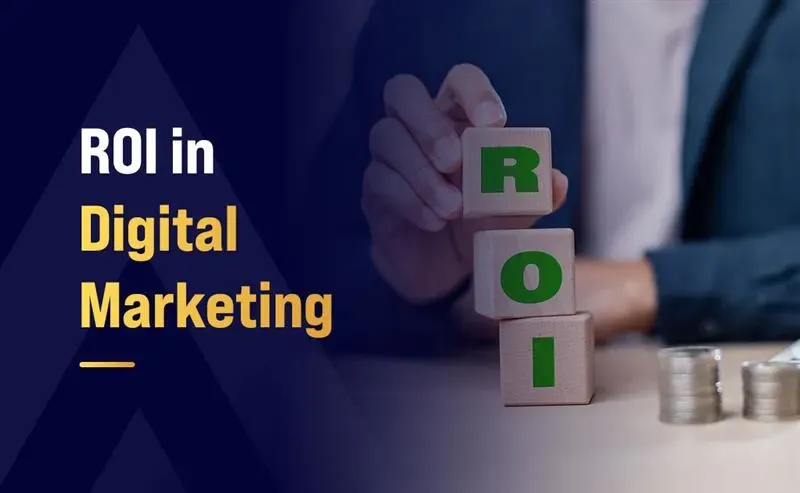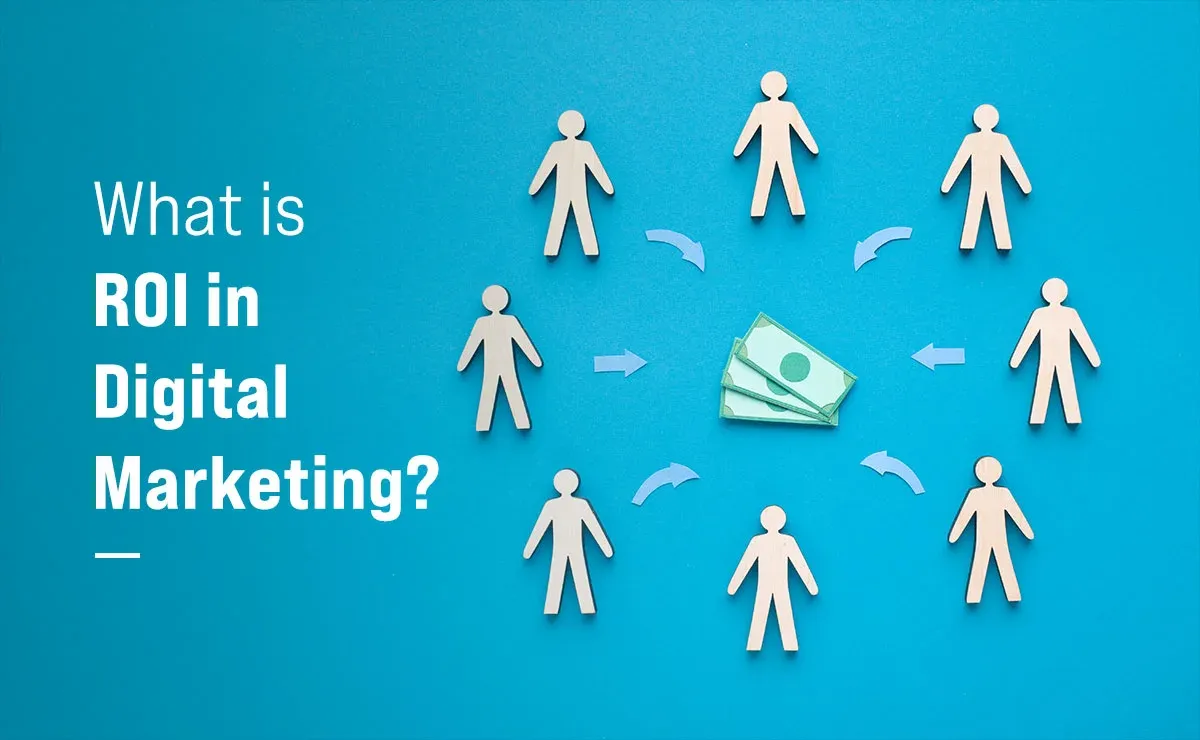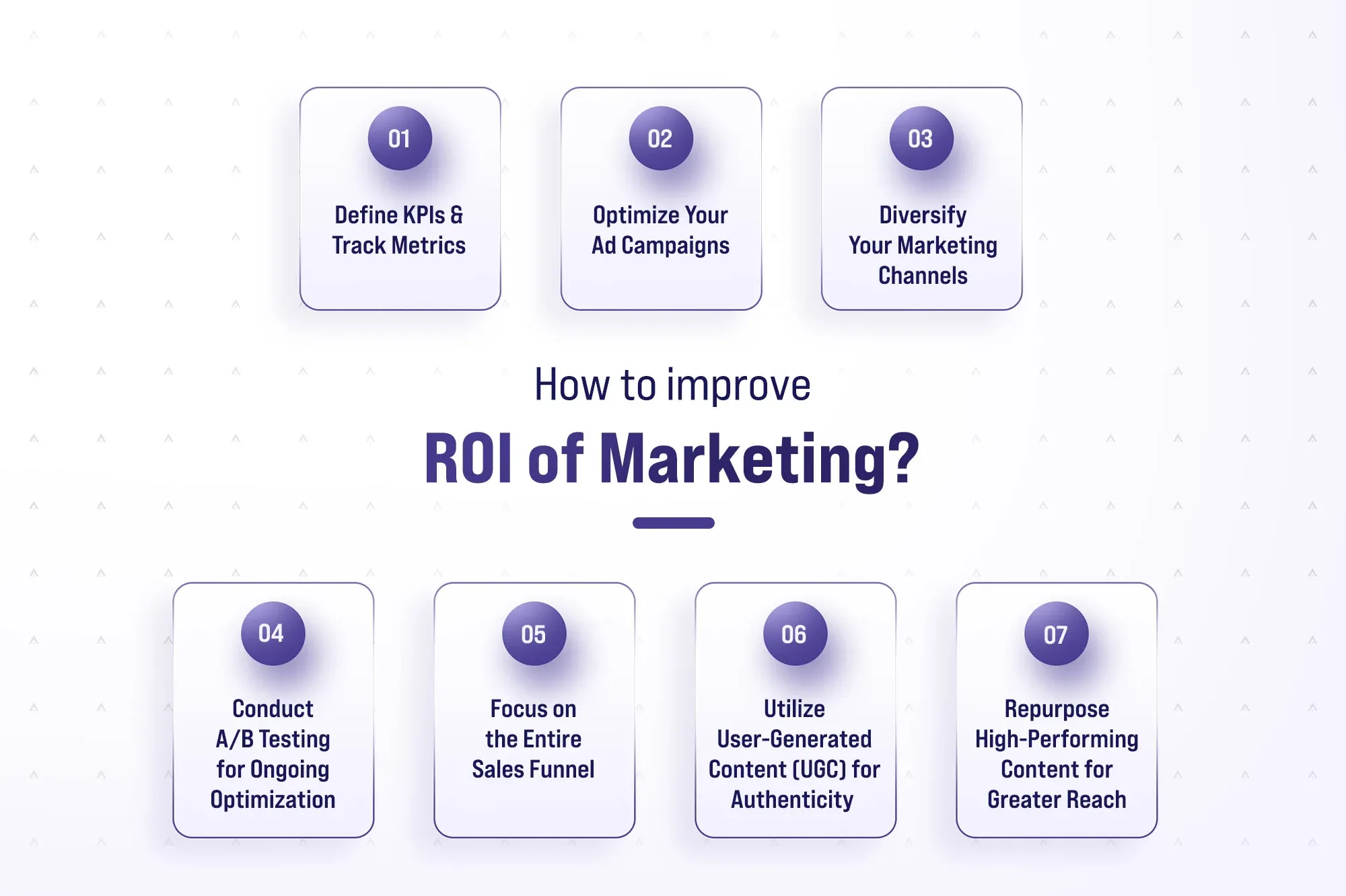What is ROI in Digital Marketing?

Digital marketing is a crucial aspect of modern-day businesses, as it helps them reach new audience demographics, increase brand awareness, and ultimately drive sales. However, as marketers juggle multiple tasks of creating content, launching ad campaigns, managing social media, and tracking analytics, not all the efforts yield the same results.
The real challenge lies in evaluating whether the campaigns being utilized are delivering profitability, which is where ROI comes into play. ROI’s full form in digital marketing stands for return on investment, and measuring it helps marketers determine what’s working and what’s not, allowing them to optimize strategies and justify marketing expenses.
This article will break down digital marketing ROI and explore how to calculate it, why it matters, how to improve it, and the best tools to track it.
What is ROI in Digital Marketing?

Digital Marketing ROI evaluates the financial success of marketing initiatives by comparing the income earned with the overall expenses of the campaign. It enables companies to assess if their marketing efforts deliver tangible results and justify the investment
Simply put, digital marketing ROI provides answers to the question, "Is the money spent on digital marketing generating more revenue than it costs?"
For example, if a company hypothetically spends ₹5,000 on a marketing campaign and earns ₹20,000 in revenue, the net profit is ₹15,000. This means the company made three times its initial investment, resulting in a 300% ROI.
While traditional marketing struggled with tracking returns, digital marketing offers instant insights and metrics, enabling precise performance assessment. Every click, impression, lead, and conversion can be tracked and analyzed to determine how marketing investments impact revenue.
How to calculate ROI in Digital Marketing?
Determining ROI in the digital marketing process helps assess whether a campaign yields higher profits than its expenditures. The basic ROI formula in digital marketing is:
ROI = (Net Profit/Total Cost) × 100
However, it is not as straightforward as measuring the ROI of traditional business, as there are many types of marketing initiatives that don’t lead to immediate revenue. Some campaigns focus on brand awareness, engagement, or lead generation, which are valuable but don’t translate directly into profit generation.
Step to Calculate the ROI of Digital Marketing
Determine Your Net Profit
Before calculating ROI, you need to identify your net profit. This is done by subtracting the total investments made for a campaign from your total revenue:
Net Profit = Total Revenue-Total Cost
For example, if an email marketing campaign generates ₹10,000 in revenue and the total cost of running the campaign was ₹2,000, the net profit is:
10,000 − 2,000 = 8,000.
Identify Your Total Marketing Costs
The total marketing cost should reflect all the expenses associated with running the campaign, such as:
- Advertising spends (Google Ads, Facebook Ads, etc.)
- Software tool subscriptions and related costs (email marketing tools, SEO, and CRM software)
- Content creation costs (copywriting, design, video production)
- Freelancer or employee salaries (if applicable)
For instance, if you spent ₹1,500 on paid ads, ₹300 on an email marketing tool, and ₹200 on content creation, then your total marketing cost would be:
1,500 + 300 + 200 = 2,000
Apply the ROI Formula
Now that we’ve calculated both net profit and total campaign costs, we can use the ROI formula:
ROI = (8,000/2,000) × 100 = 400%
This means the campaign yielded 400% returns on investments, meaning that every ₹1 invested in the campaign has generated ₹4 in profit.
By tracking costs, revenue, and key performance indicators (KPIs), businesses can optimize their marketing efforts, allocate budgets more effectively, and maximize overall profitability.
Why Measure the ROI of Digital Marketing?
Here’s why tracking digital marketing ROI is essential:
Helps Make Smarter Marketing Decisions
Measuring ROI helps businesses understand what’s working and what’s not. Examining various scopes of digital marketing approaches allows businesses to pinpoint:
- Which platforms drive the highest earnings?
- Which initiatives require refinement or optimization?
- Where should marketing funds be allocated for optimal results?
For instance, if a company notices that its email marketing campaigns generate higher conversion rates than paid social media ads, they can shift their budget towards email marketing for better returns.
Aligns Marketing Efforts with Business Growth
Growth is the goal of every company, and growth comes from increasing revenue and profitability. Measuring digital marketing ROI ensures that marketing strategies contribute to business success by focusing on initiatives that drive sales, leads, or engagement.
For example, if a company’s goal is to expand its customer base, tracking ROI on lead generation campaigns helps determine whether these campaigns are cost-effective and bring in high-quality leads that convert into paying customers.
Justifies More Marketing Budget
One of the biggest challenges of digital marketing that marketers face is proving the value of investments made for this endeavor to company leadership. As a result, ROI stands as a critical benchmark to validate the success of digital marketing initiatives.
When marketing teams can show how their efforts contribute to increased revenue, customer acquisition, or brand awareness, they can justify additional funding and persuade executives to expand their marketing budget.
Increases Measurability and Accountability
Measuring ROI helps companies optimize their marketing effort and budget allocation. It highlights top-performing campaigns and underperforming ones, enabling strategic budget allocation and minimizing inefficient spending.
Strengthens Competitive Advantage
In today’s digital-first world, businesses that measure and optimize their marketing ROI gain a competitive edge. By continuously improving campaigns, refining targeting, and maximizing returns, companies can:
- Outperform competitors in search rankings.
- Boost brand awareness and audience recall.
- Strengthen customer relationships and repeat business.
A company that monitors its digital marketing ROI can stay ahead of market trends and adapt faster than competitors who don’t track their performance.
What is a Good Marketing ROI?
Determining what qualifies as a “good” return on investment (ROI) in digital marketing depends on various factors, including industry benchmarks, business costs, and campaign goals. However, there are general guidelines that businesses can use to assess whether their marketing ROI is strong, average, or poor.
A common rule of thumb in marketing is that a 5:1 ROI ratio is considered a solid return, meaning that for every ₹1 spent on marketing, the business generates ₹5 in revenue.
- 5:1 ROI - Healthy return
- 10:1 ROI - Exceptional return
- 2:1 ROI - Barely breaking even
Anything below a 2:1 ratio is not profitable because it does not cover the production, distribution, and operational costs associated with the product or service.
Why 2:1 ROI Is Considered the Break-Even Point?
Most businesses have overhead costs, including raw materials, labor, shipping, and administrative expenses. If a marketing campaign produces only double the investment (2:1 ratio), the profits are often absorbed by these costs, leaving little to no net profit.
For example:
- If a company spends ₹10,000 on digital marketing and generates ₹20,000 in sales, they have achieved a 2:1 ROI.
- However, if 50% of the sales price goes toward production, shipping, and operational expenses, the company only breaks even instead of making a profit.
Hence, while a 5:1 ratio is a solid benchmark to measure ROI, businesses must consider their industry standards, overhead costs, and marketing goals when defining success. The key is to focus on profitable, scalable marketing efforts that yield sustainable returns over time.
How to improve ROI of Marketing?

The key to improving marketing ROI lies in optimizing efficiency, leveraging data-driven strategies, and focusing on high-performance tactics. Here are some proven methods to improve marketing ROI.
Define KPIs and Track Metrics
A successful marketing campaign begins with clear objectives and measurable key performance indicators (KPIs). Knowing which KPIs to monitor helps companies evaluate success and refine strategies. KPI metrics include:
- Marketing Efficiency Ratio (MER): Measures total revenue generated against total marketing spend. A higher MER indicates better efficiency.
- Cost Per Acquisition (CPA): Measures expenses tied to gaining a customer, aiding in smarter budget distribution.
- Click-Through Rate (CTR) & Conversion Rate: Track engagement and how effectively marketing content converts leads into paying customers.
- Customer Engagement Metrics: Analyzing website traffic, session duration, and content interaction helps refine content strategies for better results.
Optimize Your Ad Campaigns
Once your relevant metrics are in place, businesses can optimize their paid ad campaigns to achieve better efficiency.
- Keyword Research: Prioritize search terms with strong buyer intent and minimal rivalry to enhance visibility cost-efficiently.
- Ad Copy Testing: Experiment with different headlines, visuals, and CTAs and conduct A/B testing to determine which versions yield better engagement.
- Budget Allocation: Redirect funds from underperforming ads to those generating high ROI.
Diversify Your Marketing Channels
Depending solely on one marketing platform restricts audience engagement and revenue growth. Hence, diversifying across channels is the key to unlocking reach to varied customer segments. For example:
- Social media advertising may work better for engaging younger audience demographics.
- Email marketing can drive higher ROI due to its low cost and personalized engagement.
- SEO and content marketing enhance lasting brand exposure without ongoing ad expenses.
Conduct A/B Testing for Ongoing Optimization
A/B testing, or split testing, compares different versions of marketing materials like ads, emails, and landing pages to determine top performers.
- Experiment with elements like headlines, visuals, buttons, and design layouts.
- Track conversion metrics to recognize the most impactful components.
- Continuously optimize by applying insights from A/B tests to future campaigns.
Focus on the Entire Sales Funnel
Many marketers concentrate on lead generation but neglect other stages of the sales funnel. To improve ROI:
- Analyze performance at every stage, from awareness to conversion.
- Spot abandonment stages where potential buyers lose interest.
- Deploy retargeting ads to recapture lost prospects.
- Optimize the buying journey to eliminate hurdles and boost purchase completion rates.
Utilize User-Generated Content (UGC) for Authenticity
User-generated content (UGC) is a cost-effective way to build trust and engagement. It includes leveraging aspects like:
- Customer reviews and testimonials.
- Social media posts featuring brand products.
- Video testimonials or unboxing videos from customers.
This demonstrates that the customers who have engaged with the brand and their offerings trust them. Hence, it not only increases their desirability in the long run but also helps reduce content creation costs, enhances the credibility of the brand, and encourages higher engagement and organic reach.
Repurpose High-Performing Content for Greater Reach
Repurposing existing content broadens audience reach while saving resources.
- Convert blog posts into social media snippets.
- Transform webinars into short-form videos for platforms like Instagram Reels or YouTube Shorts.
- Turn eBooks or reports into infographics for quick visual engagement.
This method extends the lifespan of valuable and impactful content without extra costs.
Which digital marketing channels have the highest ROI?
Email marketing stands out as the most efficient channel, consistently delivering exceptional returns at minimal costs. On average, email marketing yields a staggering $36 to $40 for every $1 spent, translating to an ROI of 3,600%, far exceeding other digital marketing channels.
Reasons why Email Marketing delivers high ROI?
- Low Cost, High Impact: Unlike paid advertising, email marketing requires minimal investment. Businesses only need an email marketing platform and a well-segmented contact list to start generating leads and conversions.
- Tailored and Direct Engagement: Email campaigns enable hyper-personalized messaging based on user actions and preferences. This personalization significantly increases open rates, engagement, and conversions.
- Automation and Scalability: With marketing automation tools, businesses can send automated welcome emails, cart abandonment reminders, and promotional campaigns without constant manual effort, making it a highly scalable strategy.
- Customer Retention and Loyalty: Maintaining current customers requires significantly fewer resources than prospecting new ones. Email nurtures long-term relationships, driving repeat sales and higher lifetime value.
- Performance-Based Refinement: Email analytics reveal open rates, CTRs, and conversions for continuous improvement. Marketers can continuously test and optimize subject lines, content, and call-to-action buttons to improve performance.
What Tools Help Monitor Digital Marketing ROI?
Using the right tool according to digital marketing necessities can help analyze website traffic, track conversions, monitor user behavior, and assess campaign performance. Here are some of the best tools to measure digital marketing ROI:
- Google Analytics (Best for Website Traffic Insights): Google Analytics is a must-have tool for tracking website performance. It provides insights into traffic sources, user behavior, and conversions, helping businesses understand which marketing efforts drive the most engagement. With Google Analytics, you can also monitor bounce rates, keyword performance, and the effectiveness of SEO and PPC campaigns.
- SEMrush (Best for SEO & Competitive Analysis): SEMrush is a comprehensive SEO tool that helps businesses track keyword rankings, backlinks, and ad campaigns. It also offers competitive analysis features, allowing businesses to see how their SEO efforts compare to competitors. With SEMrush, businesses can refine their search engine strategies and improve their organic visibility.
- Ahrefs (Ideal for In-Depth SEO Analysis): A premier SEO tool for backlink audits, keyword tracking, and competitor insights, perfect for optimizing content and link-building strategies.
- Cyfe (Top Choice for Custom Dashboards): An all-in-one analytics platform consolidating marketing data for streamlined decision-making. It offers pre-built widgets that let you monitor SEO, social media, PPC, and other key data points. Custom dashboards prioritize relevant metrics, improving strategic agility.
- RevenueCloudFX (Best for Lead & Call Tracking): RevenueCloudFX is an AI-powered tool designed to track leads and phone call conversions. It helps businesses understand how leads arrive at their website, what pages they visit, and what triggers them to take action.
Businesses should explore tools tailored to their goals for smarter, ROI-driven marketing.
Summing Up
Assessing digital marketing ROI is vital for campaign optimization and profit growth. By tracking key performance metrics, leveraging high-ROI marketing channels, and using the right ROI tracking tools, businesses can make data-driven decisions that lead to long-term success.
Achieving a strong ROI isn’t just about increasing marketing spend—it’s about spending smarter by refining ad campaigns, diversifying marketing efforts, and continuously optimizing based on data insights. With the right approach, businesses can not only boost revenue but also strengthen their competitive advantage in the digital landscape.
With the right tactics and tools, brands can achieve sustainable growth, engagement, and profitability in the digital landscape.





